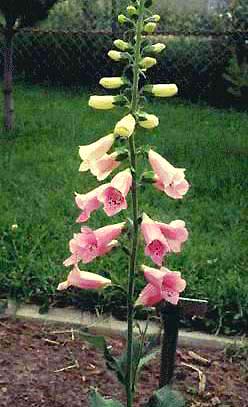Foxglove, Digitalis
Digitalis purpurea & lanata In contrast to most poisonous plants used in medicine, digitalis was unfamiliar to people in ancient times and, therefore, there are no myths and mysteries about this summer flower. |
The first reports about it date from 1542, when the German physician and professor of botany Leonard Fuchs compiled a herbarium of all plants known at that time. He gave the plant its name (digitulus meaning a "small finger") because its blossoms were similar to a thimble. Digitalis is a perennial herbaceous plant, up to 120 cm high, and has long leaves. Its native land is West Europe (Ireland) but it is already cultivated in many countries around the world. The whole plant is poisonous because every part of it contains the cardiac glycosides digitoxin (the most important one), gitoxin, digoxin and also some saponins.
In fact, the
foxglove was traditionally used in Irish and Scottish folk medicine, but
it first entered the pharmacopoeia of London in 1722 and later that of
Edinburgh (1744), Paris (1756) and Würtemberg (1754). At that time,
digitalis was used in enormous doses exclusively as a laxative drug that
led to many severe poisonings and deaths, which is why it was consequently
rejected. |
|
It was William Withering, a young doctor at the Birmingham Municipal Hospital, who renewed the interest in digitalis. He decreased the dose and emphatically denied its action as a laxative. However, it was not until 1850 that the effect of digitalis on the heart muscle was revealed by the German pharmacologist Traube. He pointed out that the stimulating effect of digitalis occurs under the application of moderate doses, whereas a high dose can provoke paralysis of the heart muscle and nerves.Nowadays, it is well known that if more than 2 mg of digitoxin are injected intravenously, the slower heartbeat may be followed by arrhythmia and cardiac arrest. A number of medicines are produced from the substances extracted from the plant. Such medicines are highly valued by cardiologists and are still irreplaceable for many patients.

